 Motors are employed across the industrial sector. As the technology that goes into motors becomes more and more complicated, it is vital for engineers and technicians to know about what causes electric motor failure. Trouble is, the causes of electrical motor failure are nuanced and complex, since various issues can contribute to a problem that will ultimately lead to the failure of a motor. As such, troubleshooting electric motor failure is a topic that must be broken down into several different categories.
Motors are employed across the industrial sector. As the technology that goes into motors becomes more and more complicated, it is vital for engineers and technicians to know about what causes electric motor failure. Trouble is, the causes of electrical motor failure are nuanced and complex, since various issues can contribute to a problem that will ultimately lead to the failure of a motor. As such, troubleshooting electric motor failure is a topic that must be broken down into several different categories.
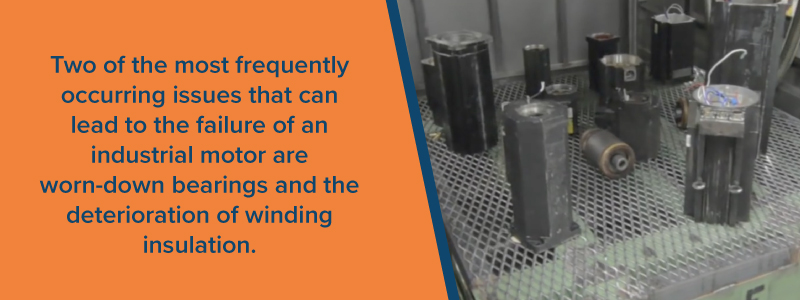
Two of the most frequently occurring issues that can lead to the failure of an industrial motor are worn-down bearings and the deterioration of winding insulation. However, either one of these conditions could stem from any given number of factors, such as the following:
- Power quality issues: Problems that affect the quality of power in an electrical motor are usually the result of transient voltage, voltage imbalance or harmonic distortion.
- Variable frequency drive issues: When a motor shows signs of trouble in this area, the issue usually comes down to sigma current, overload or reflections on the drive output.
- Mechanical issues: In cases where the problem is due to a faulty mechanism, the issue will usually stem from misalignment, bearing wear or a loose or imbalanced shaft.
- Installation issues: Sometimes when a motor displays problem symptoms, the issue is down to faulty installation, which can cause problems like soft foot, pipe stain and shaft voltage.
To truly understand, identify, diagnose and ultimately prevent the common causes of electric motor failure, each cause needs to be explored in depth.
Power Quality Issues
- Transient Voltage
Along the distribution system of an industrial plant, a case of transient voltage could arise from a variety of internal or external factors. Two of the most common causes include:
- When neighboring loads power on or off
- Environmental conditions brought on by outside weather
The transients in question can range in amplitude and persistence. In any case, transient voltage will typically eat away at insulation in the motor windings. Transient sources are difficult to pinpoint they also happen to be rare in occurrence. Furthermore, the symptoms of transient voltage often vary.
While a transient can arise on a control cable, it is often hard to identify the problem because the equipment itself might not be damaged, yet the operations will be hindered. In a lot of cases, the breakdown of insulation in the motor winding will cause the motor to wear out before its time.
Transient voltage is a critical issue that can be diagnosed with the use of a three-phase power quality analyzer.
- Voltage Imbalance
Single-phase loads are generally served in three-phase systems of distribution. If the impedance is off or if the load distribution is imbalanced, the three phases of distribution will become imbalanced. The three most likely ways for an imbalance of voltage to arise would be:
- Problems with the motor cabling
- Terminations on the motor end
- Trouble with the winding components
In power systems that consist of three phases, a voltage imbalance can cause stress along each of the three phases.
When imbalances occur, the excessive flow of electrical current in one of the phases — or possibly two or three — can cause the operating temperature to rise, which in turn can eat away at the insulation. As such, it is important for each phase to carry the same level of voltage. Occurrences of voltage imbalance can be identified with the use of a three-phase power quality analyzer.
- Harmonic Distortion
When a motor winding is hit with an extraneous, unintended source of AC current, the phenomenon is known as harmonic distortion. The extra energy that circulates in such instances is of no use to the rotation of the motor shaft. What the harmonic actually does is circulate in the winding components and consume excess energy. As time goes on, harmonic distortion causes heat to build up, the effects of which will compromise the insulation in the winding parts.

To a small extent, harmonic distortion is actually a normal part of the way things function in systems that serve electronic loads. In fact, each harmonic has its own tolerance level for distortion. To inspect whether the level of distortion is acceptable, a three-phase power quality analyzer is necessary. The purpose here is to see if either the level of electrical current or the temperature are excessive.
Ultimately, too much harmonic distortion is detrimental to the efficiency of a motor. The effects of this problem can send temperatures and overhead costs soaring.
Variable Frequency Drive Issues
- Reflections on Drive Output PWM Signals
To control the amount of voltage that gets sent to a motor, variable frequency drives use what is known as pulse width modulation (PWM). In cases where the impedance becomes imbalanced between the load and the source, reflections occur. An impedance mismatch is liable to arise due to the following factors:
- Poor installation
- Mismatched components
- Worn or aged equipment
Granted, the height of the reflection can possibly be as intense as the voltage level of the DC bus in the drive circuit of a motor.
Ultimately, the erosion of insulation within the motor winding can lead to unexpected and often costly downtime. Problems such as these are of high consequence and should be investigated and diagnosed with a four-channel oscilloscope.
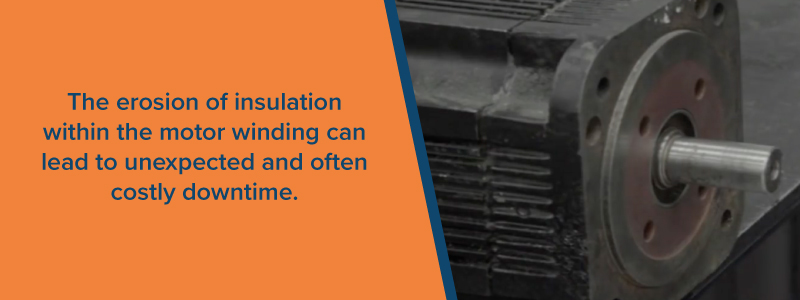
- Sigma Current
When currents go astray within the system of a motor, the phenomenon is known as sigma currents. The cause of sigma currents is usually down to one of the following factors:
- The level of voltage
- The frequency signal
- Conductor inductance and capacitance
When sigma currents arise, the effect can cause the windings to overheat. Sigma currents can be identified by the sum of the currents from all three phases. Ideally, the sum of all three currents combined would amount to zero. To and from the drive, the return current and outgoing current should be equal to one another. Overall, sigma current is a minor problem that can be measured with the use of a four-channel oscilloscope.
- Operational Overloads
In cases where the motor bears an excessive load, the motor is prone to a condition known as operational overload or motor overload. When motor overload occurs, the problem is usually down to one of the following symptoms:
- Slow torque
- Extreme current draw
- Soaring heat
In cases where overheating becomes a factor, operational overload is one of the leading causes of motor failure. Often, the overheating will commence yet the parts within the motor — such as the bearings and windings — continue to run as normal. Therefore, when a motor starts to overheat yet all the parts appear to be working as normal, one of the first things to consider is the possibility of motor overload.
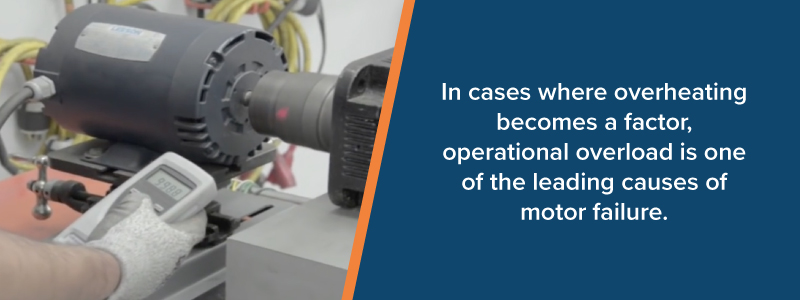
In terms of its impact on a motor, overload inflicts premature wear on all facets of the motor components, both electrically and mechanically, all of which can cause a motor to give out before its time. Operational overload accounts for nearly a third of all motor failures, which makes it crucial to know how to identify the problem before it spirals out of hand. The problem can be diagnosed with the use of a digital multi-meter device.
Mechanical Issues
- Misalignment
In cases where the drive shaft of the motor is improperly aligned with the load, you have what is simply known as misalignment. Alternately, the problem can arise in cases where the coupling part of the motor is not properly aligned. While it is often assumed that misalignment can be compensated for with flexible coupling, all this really does is safeguard the coupling itself.

A misaligned shaft will inflict troublesome cyclical impact across the shaft despite flexible coupling. When this occurs, the mechanical overload increases and the motor incurs undue strain. Moreover, misalignment increases the amount of vibration within the load as well as the shaft of the motor drive. Cases of misalignment can be broken down into three different types:
- Angular misalignment: Where the centerlines of the shaft run non-parallel and intersect.
- Parallel misalignment: Where the centerlines of the shaft run non-concentrically parallel.
- Compound misalignment: A combination of the angular and parallel misalignment problems.
In many cases, misalignment is a combination of angular and parallel problems. However, the problem is often discussed as two separate forms of misalignment because it is generally easier to deal with each individually.
The impact of misalignment on an industrial motor is serious, as the problem causes undue wear on the pieces of the mechanical drive. This leads to early failure. Misalignment is a critical problem that can be diagnosed with the use of a laser shaft alignment tool.
- Shaft Imbalance
In motors where the center of the rotational part does not meet the axis, the abnormality is referred to simply as a shaft imbalance. The situation is problematic because it places a heavy mass at some point along the rotor rather than at the axis, where it belongs. While it is virtually impossible to completely prevent motor imbalance from ever happening, it is none-too-hard to tell when the motor is off of its ideal range.
Shaft imbalance is usually down to one of the following problems:
- Deposits of dirt
- Insufficient balance weights
- Lopsided mass in the windings of the motor
- Issues related to parts wear
When an imbalanced shaft is recognized, steps to rectify the matter should be taken immediately. The problem can cause undue wear within the parts that comprise the mechanical drive, and this can lead to early failure of the motor. One of the easiest ways to identify shaft imbalance is with the use of a vibration tester.
- Shaft Looseness
When an excess amount of clearance appears at the shaft, the problem is referred to simply as shaft looseness, which can occur in the following ways:
- Rotating looseness: This occurs when too much clearance exists between the moving and still parts of the motor, such as between the bearing and surrounding parts.
- Non-rotating looseness: This is characterized by looseness between two still parts of the motor, neither of which are supposed to move, such as the bearing enclosure and adjacent parts.
The impact of shaft looseness can lead to undue wear on the rotating parts of a motor, which can in turn cause mechanical failure. Therefore, it is crucial to identify instances of shaft looseness in an industrial motor before the problem becomes damaging and costly. The easiest way to spot the problem is with the use of a vibration tester, which can help you verify if looseness is present along the rotating components.
- Bearing Wear
When a bearing becomes worn, it will tend to move slower, grow hotter and become generally less efficient. The problem is typically down to age, mechanical issues or insufficient lubrication. The failure of bearings often stems from the following issues:
- Loads that are too heavy for the motor
- Problems with the lubrication, such as the wrong grade or an insufficient quantity
- A misalignment of the shaft
- An improper fitting
- Bearing wear due to age
Bearing failure can lead to a slippery slope of problems for an industrial motor. More than 13 percent of motor failures are down to failure of the bearings. Likewise, nearly two-thirds of failures that occur at mechanical facilities are the result of worn bearings. Therefore, it is crucial to spot and remedy instances of bearing wear. The problem can be diagnosed with the use of a vibration tester.
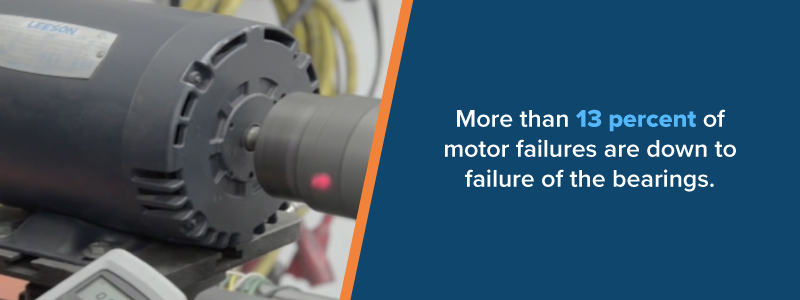
Installation Issues
- Soft Foot
When a motor has uneven mounting feet, the problem is known as soft foot. The problem can also occur when the feet are placed on an uneven mounting surface. In any case, soft foot is a troubling issue that can easily lead to more problems. For instance, if you attempt to rectify the problem by tightening the mounting bolts, further misalignment can easily result.
Oftentimes, soft foot is the result of a pair of mounting bolts that have been positioned diagonally from one another. The effect is akin to when a four-legged chair rocks back and forth diagonally due to unevenness between opposite legs. Soft foot occurs in one of two variations:
- Parallel soft foot: Where one mounting foot is higher than all of the rest.
- Angular soft foot: Where one mounting foot is uneven with the mounting surface.
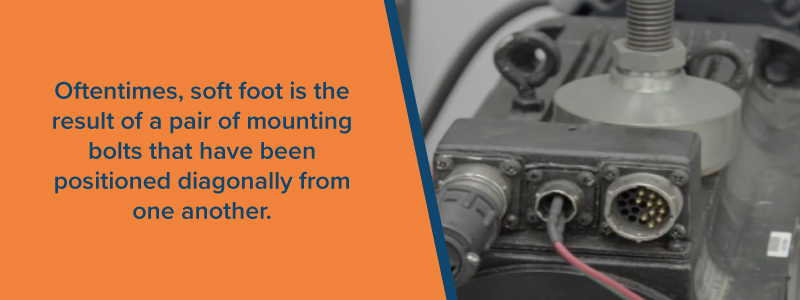
Soft foot is generally the result of problems with either the mounting feet or the mounting surface. Either way, issues of soft foot must be rectified for a motor to be properly aligned at the shaft. The easiest way to identify a case of soft foot is with the use of a laser alignment tool. Even though the problem is not exactly critical, soft foot can cause the components of a mechanical drive to fall out of alignment.
- Pipe Strain
When the motor and drive fall into misalignment due to stress that originates from the surrounding components, the problem is referred to as pipe strain. Basically, the stress enacted upon the other equipment transfers back to the motor itself. In most cases, pipe strain originates from the following changes:
- Movements in the foundation
- New valve installations
- Physical impact on a pipe
- Damage to the pipe hangers
When one of these issues comes into play, it will often result in a misalignment of the motor/pump shaft. Therefore, it is important to inspect the alignment of the machine time and time again. The correct alignment of a new machine is rarely permanent, as alignments are bound to change over time unless maintenance is performed on a periodic basis.
In the short term, the consequences of pipe strain are slow and minor. If left to persist, however, pipe strain and its resulting stresses can contribute to the early failure of an industrial motor. The problem can be diagnosed with the use of a laser shaft alignment tool.
- Shaft Voltage
When flashover currents travel to the outer bearing of a motor and impact the races, the problem is down to shaft voltages that surpass the insulation limits of the bearing lubrication. As the problem commences, the shapes of the bearings become compromised due to overheating, which causes fragments of the metal to bleed into the lubrication and corrupt its viscosity. This leads to increased friction, which becomes readily apparent through the noise and vibrations caused by the problem.
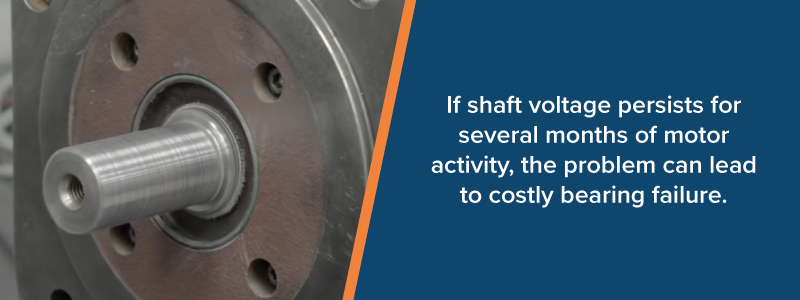
If shaft voltage persists for several months of motor activity, the problem can lead to costly bearing failure. While it is crucial to identify and remedy shaft voltage, the problem is only apparent when the motor is active. The easiest way to diagnose the problem is with the use of a carbon brush probe, which makes it possible to gauge the shaft voltage as the motor rotates.
How to Set Yourself Up for Success
Motor control systems have been employed for a vast range of vital operations at industrial facilities throughout the world. Consequently, the failure of motorized equipment can have a disastrous financial impact on industry. Therefore, it is crucial for industrial technicians to know how to identify problem issues early and implement solutions as soon as possible.
With preventative maintenance, routine inspections and knowledgeable troubleshooting, costly problems can largely be avoided. Motor restoration and failure prevention can be accomplished in most cases with the following four strategies:
- Keep notes of the motor specs and range of tolerance as well as the conditions in which the motor operates.
- Keep notes on the key measurements of a motor at the time of installation and other critical junctures, like before and after each round of maintenance.
- Keep a record of every measurement to study over time. This can help you identify changes in the condition and measurement trends as the motor ages.
- Study individual measurements to identify the standard trend. If line-deviances exceed 10 percent, investigate the issue to determine the cause.
Whether you have your motor fixed in-house or send it to a service center, the records that you keep on the performance and measurements of the motor will help to make the servicing work easier and faster.

Electric Motor Repair and Service
No matter what causes electric motor failure, any problem that arises should be examined and diagnosed immediately when symptoms become apparent. When problems are identified, troubleshooting electric motor failure is not difficult to accomplish as long as skilled and qualified technicians are on hand.
Sometimes, however, the causes of electric motor failure are either too complicated or too advanced to be reversed by the in-house technicians at most industrial facilities. When problems like these occur, the best solution is to bring the motor into a service center to have it professionally diagnosed and repaired by licensed tech professionals.
At Global Electronic Services, we perform repairs on a vast range of industrial motors. Our technicians are experts at servicing motors and pneumatic equipment from more than 60,000 manufacturers and distributors. They can fix all the most common causes of electric motor failure. To learn more about our repair services, contact Global Electronic Services and ask to speak with one of our technicians.
